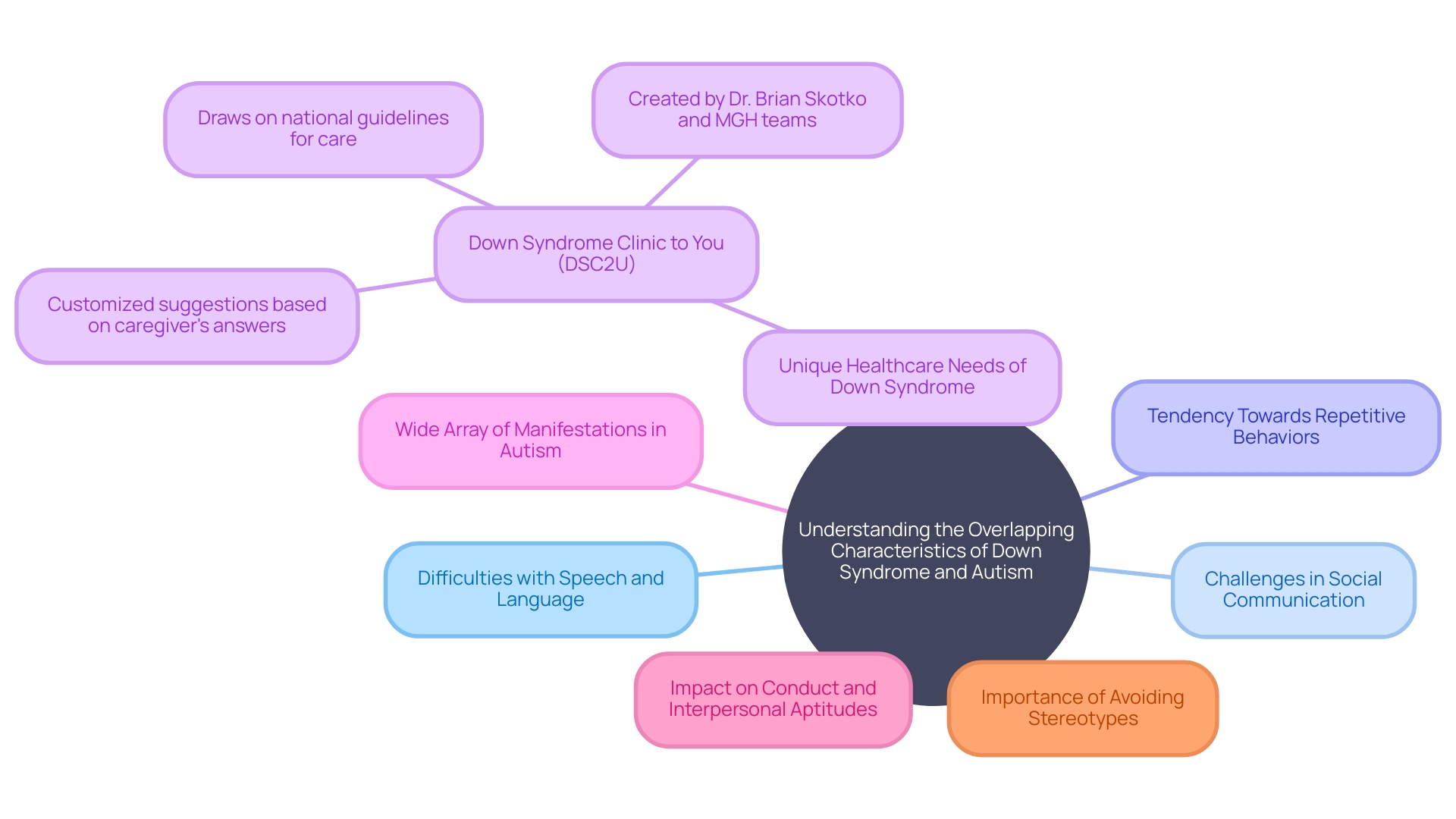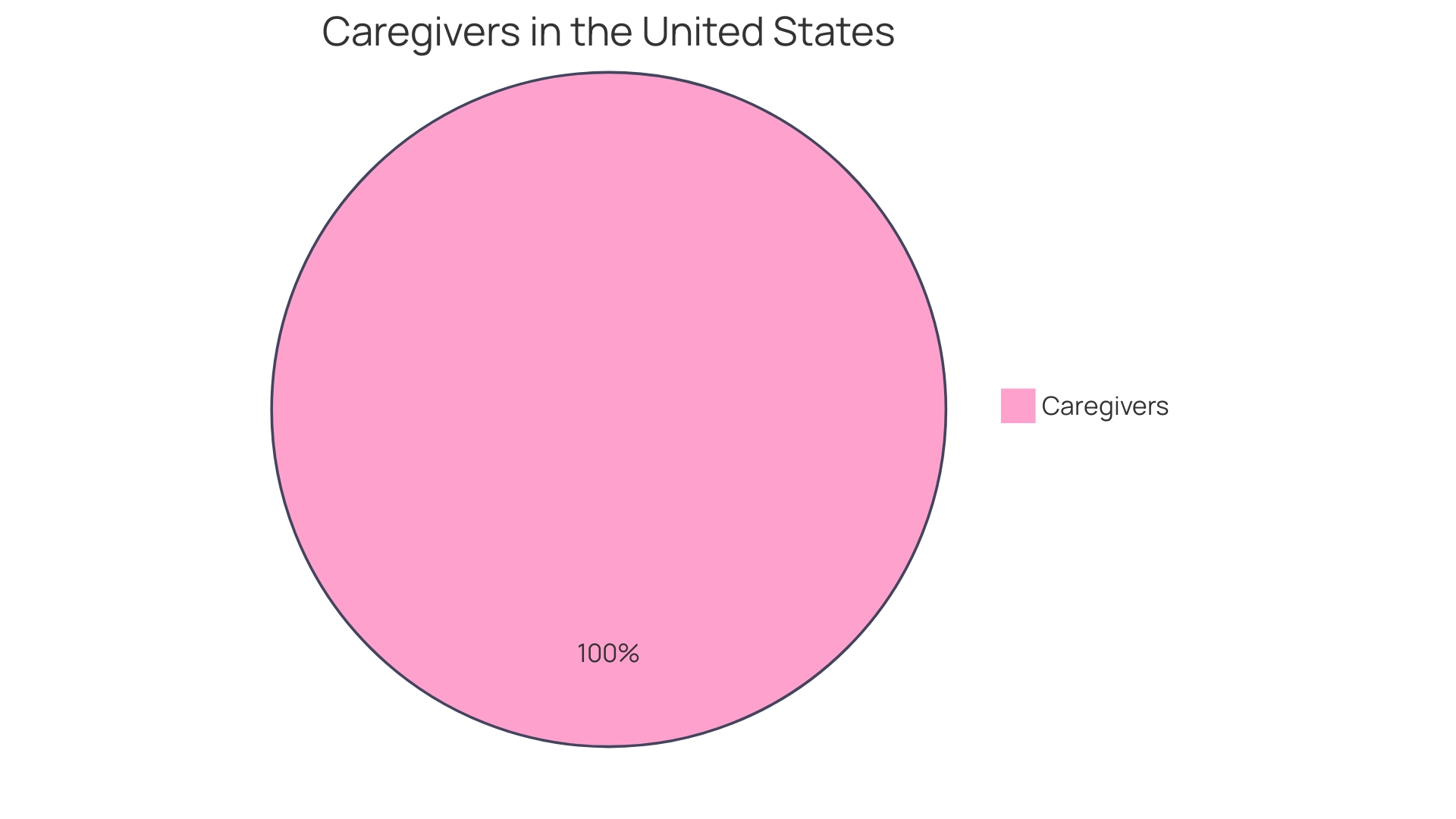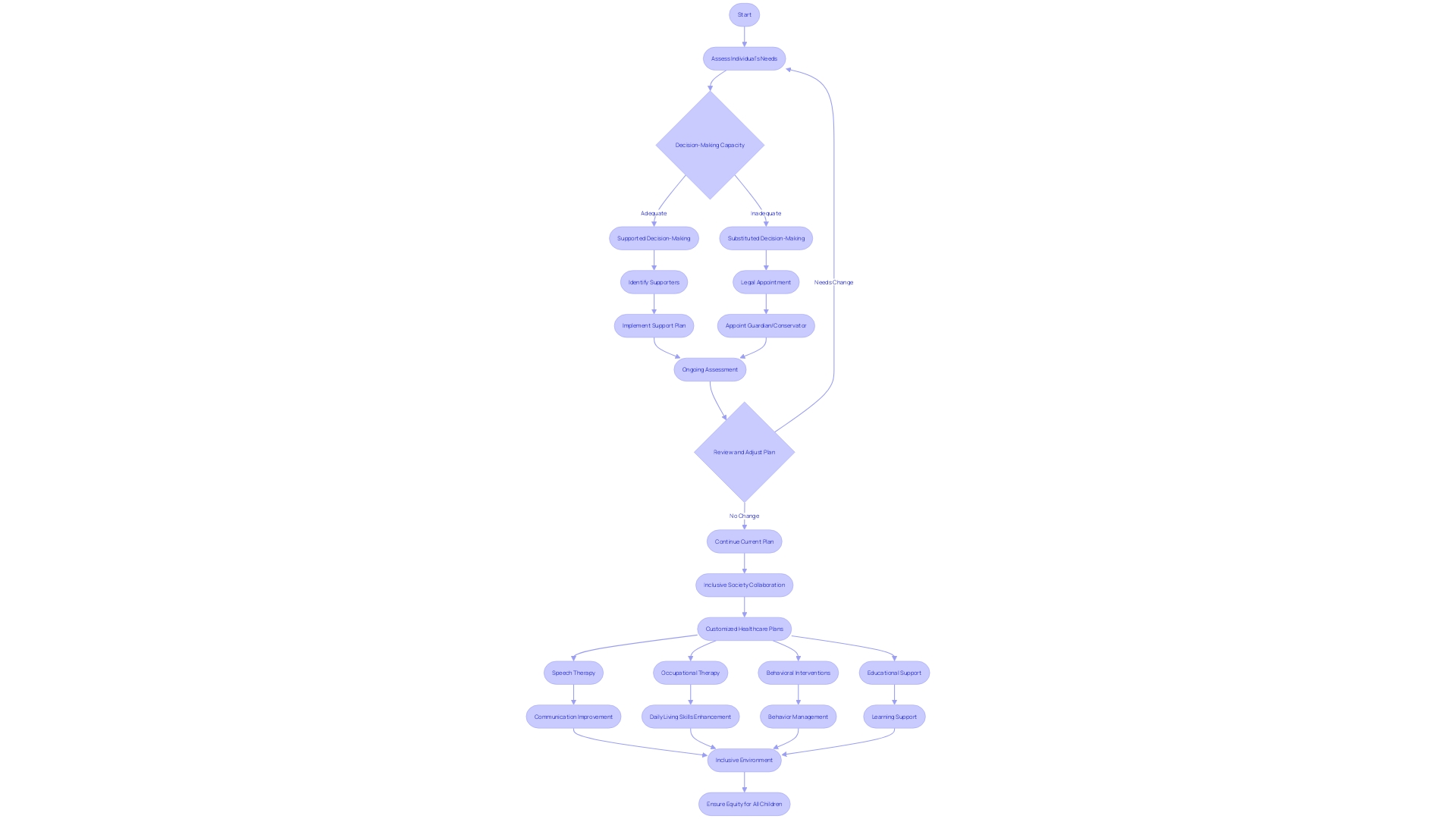Introduction
Individuals with Down Syndrome (DS) are at a heightened risk of developing autism spectrum disorder (ASD), requiring a tailored approach to care and support. This article explores the prevalence of autism in individuals with DS, the challenges in diagnosing ASD in this population, common symptoms and traits of both conditions, the impact of dual diagnosis on families and caregivers, strategies for support and intervention, and the importance of creating supportive environments. By delving into these topics, we aim to empower Parent Advocates with the knowledge and resources to navigate the complexities of raising children with DS and autism, ensuring their well-being and fostering a more inclusive society.
Prevalence of Autism in Individuals with Down Syndrome
Research has illuminated that individuals with Down (DS) are at a heightened risk for developing autism spectrum disorder (ASD). This intersection of DS and ASD necessitates a more nuanced approach to care and support, tailored to the distinct needs of those affected by both conditions. Rigorous ethical standards and oversight, such as the approval by the Danish Data Protection Agency and adherence to privacy regulations, ensure the integrity of such research. Studies like these are pivotal in enhancing our understanding of the quality of life for those with DS, as underscored by Dr. Daniel J. Kats' work, which represents the first international effort to holistically assess well-being across multiple countries.
World Down Disorder Day, acknowledged by the United Nations, emphasizes the significance of advancing our understanding about DS, particularly regarding the early onset of Alzheimer's disease in this population, as noted by Dr. Frederick Schmitt. Moreover, results from the Down Syndrome Societal Services and Supports Survey, involving specialists from around the world, expose noticeable discrepancies in the quality of life for persons with DS that differ greatly from one nation to another. This global partnership, motivated by a common enthusiasm among leaders in the Down syndrome advocacy community, highlights areas where enhancements are needed to improve the welfare of people with DS.
The concept of neurodiversity is also gaining traction, reshaping our understanding in fields such as science and medicine, by highlighting the distinct contributions of neurodivergent people, which include those with ASD and DS. The social model of disability within this framework advocates for societal changes to better accommodate neurodivergent people, thereby reducing the barriers they face. This paradigm shift towards a more inclusive society is crucial for improving the lives of those with neurodivergent conditions.

Challenges in Diagnosing Autism in Individuals with Down Syndrome
The complex process of identifying ASD in individuals who also have Down is filled with intricacies. Intellectual disabilities and nuanced communication barriers often seen in Down Syndrome may mask symptoms of another neurodevelopmental disorder, thereby complicating the diagnostic process for healthcare professionals. The challenge lies in discerning the nuanced distinctions between the shared characteristics of both conditions. It's crucial to integrate detailed observations of behavior and comprehensive developmental histories from parents or caregivers as outlined in the DSM-5 diagnostic criteria. This multifaceted approach, combined with specialized assessments from neurodevelopmental experts, can lead to more accurate and informed diagnoses. It's a call for a deeper, more nuanced understanding of these overlapping conditions, recognizing the importance of precise diagnosis for effective intervention and support. Based on the CDC's findings, the prevalence of autism can be observed in up to 1 in 36 people, highlighting the need for precise identification despite the complexities involved in diagnosing this condition. The journey toward a definitive diagnosis is further complicated by the fact that ASD is defined by a spectrum of behaviors and its manifestations are unique to each individual. With no single cause identified for the condition, it is acknowledged that neurological differences play a significant role. In the meantime, global studies on Down Syndrome, such as the Down Syndrome Societal Services and Supports Survey, reveal the disparities in quality of life and healthcare, emphasizing the need for tailored policies and community assistance that can adapt to the specific needs of those with dual diagnoses.
Common Symptoms and Traits of Down Syndrome and Autism
Down Syndrome and autism, despite having distinct diagnoses, can display overlapping characteristics, like difficulties with speech and language, challenges in social communication, and a tendency towards repetitive behaviors. Understanding these similarities is crucial, but it's equally important to acknowledge the unique aspects of each condition to provide the most effective support and care. Down, a chromosomal disorder occurring in about 1 in 1,000 births, has its own specific healthcare needs. Resources like the Down Syndrome Clinic to You (DSC2U) can offer personalized health and wellness information to caregivers worldwide, ensuring that geographical location and financial status do not become barriers to accessing top-tier medical advice. Conversely, ASD encompasses a wide array of manifestations that can greatly impact a person's conduct, interpersonal aptitudes, and verbal proficiency. ASD persists throughout a person's life, necessitating an informed and understanding approach from all who interact with people with ASD. Addressing these conditions with sensitivity and avoiding stereotypes is key, as misconceptions can be not only inaccurate but also harmful. It's crucial to bear in mind that people with Down Syndrome or ASD are as diverse as the conditions themselves, and each person deserves care and attention customized to their unique needs and strengths.

Differences in Presentation: Down Syndrome with Autism vs. Down Syndrome Alone
People who have both Down Syndrome (DS) and autism can face a distinct set of challenges that are significantly different from those experienced by people with Down Syndrome alone. Research indicates that these individuals often face more pronounced difficulties in social communication, exhibit a higher frequency of repetitive behaviors, and may encounter additional obstacles in daily adaptive functioning. Recognizing these distinct needs is essential for tailoring the right support and interventions. Stories like that of Ellie Goldstein, who has defied expectations by becoming the first model with Down to feature on the cover of Vogue, underscore the importance of breaking stereotypes and recognizing the potential within this diverse community.
Globally, the quality of life for people with DS varies significantly. A groundbreaking international study, led by Dr. Daniel J. Kats and contributed to by advocates without funding, has sought to holistically assess well-being by developing the Down Syndrome Societal Services and Supports Survey. The study revealed varying rankings in quality of life across countries, with the United States placing 13th overall among 45 countries. These findings highlight the crucial role of social support and inclusion in shaping the lives of those with DS.
As we move ahead, it is vital to dismantle misunderstandings and support all-encompassing approaches that promote community involvement, education, healthcare, and independence for individuals with DS, including those who have the supplementary diagnosis. This advocacy is not just about improving statistics but about empowering every person to reach their full potential, as demonstrated by the remarkable achievements of people like Ellie Goldstein.
Impact of Dual Diagnosis on Families and Caregivers
Navigating the complexities of caring for an individual with both Down Syndrome and autism presents multifaceted challenges for families and caregivers. The combined diagnosis often requires a deeper engagement with healthcare systems, educational assistance, and therapeutic services, which can be noticeably overwhelming. Author Kelley Coleman illuminates this journey in her upcoming book, Everything No One Tells You About Parenting a Disabled Child, providing a vital resource for those seeking guidance on vital systems, services, and assistance. Her work underscores the importance of equipping caregivers with the necessary tools for effective advocacy and management of their loved one's needs.
The emotional and financial toll on families is profound, with over 80% of caregivers indicating an increase in their responsibilities due to the decreased availability of services, as revealed in a survey by The Arc and the Research and Training Center on Community Living at the University of Minnesota. The necessity for a just and equal approach to assistance, as stressed by the deceased Dr. David (Dan) R. Offord, is crucial in guaranteeing that children with disabilities encounter significant social involvement and that their families obtain the aid necessary for their well-being.
With the relentless evolution of medical and therapeutic advancements, caregivers must stay informed about new treatments and medications, balancing the benefits and risks while monitoring the impact on their child's behavior. As Coleman's narrative and the experiences of those like Courtney Baker, a mother who chose to embrace her child with Down's condition, illustrate, the strength and resilience of caregivers are paramount. Their stories, coupled with expert insights, serve as a guiding light for others navigating similar paths, highlighting the necessity of access to comprehensive assistance systems that uphold the mental health and equity of children with disabilities and their families.

Strategies for Support and Intervention
Creating a comprehensive strategy for people with the co-occurring conditions of Down Syndrome and autism necessitates a network of specialized assistance and care. It's essential to weave together speech therapy, occupational therapy, behavioral interventions, and educational support. Each thread in the plan is customized to the person's distinct abilities and challenges, guaranteeing they are not just participants in their own race of life, but contenders.
Dr. Federica Rossi, a proponent of multidisciplinary research, has emphasized the transformative impact of such an approach, asserting that it is more likely to result in innovations that address real-world issues. This aligns with the American Heart Association's insights highlighting the interconnected health challenges faced by children with Down Condition, including congenital heart disease, which affects 35-50% of these children.
Inclusion from early childhood is paramount, as reinforced by legal frameworks like the Individuals with Disabilities Education Act, which underscores the importance of individualized programming. Resources are shared among educators, healthcare providers, and families to foster an inclusive environment from the start, recognizing that every child, including those with disabilities, has unique needs and contributions to society. This is a race where equity ensures that no child is left behind, echoing the sentiments of Dr. David (Dan) R. Offord, who envisioned a fair race for all children.
In practice, this entails developing customized healthcare plans using resources like the DSC2U survey, which draws from national guidelines to assist individuals with Down's condition. With approximately 5,300 babies born with Down annually in the United States, and a population living longer than ever before, the imperative for a fair and supportive race is more pressing than ever. Collaborative efforts among all stakeholders are not just beneficial; they're a necessary stride toward a more inclusive society.

Creating Supportive Environments for Individuals with Down Syndrome and Autism
Establishing an inclusive setting is vital for the well-being of individuals with Down Syndrome and individuals with special needs, as it caters to their need for predictable structure and accommodates their unique learning preferences. Tailoring education and care to include visual learning techniques, such as the TEACCH approach, can significantly improve their academic and personal development. By implementing visual schedules and emphasizing clear, consistent communication methods, educators and caregivers can facilitate a more accommodating and engaging atmosphere.
Moreover, fostering social inclusion is not just about creating a supportive space but also about challenging deep-rooted stereotypes and promoting acceptance. The neurodiversity movement emphasizes the value of neurological differences like autism and ADHD, encouraging a shift away from medical models that view these conditions as disorders needing correction. Instead, it promotes the celebration of these distinctions and offering assistance that corresponds to each person's requirements and potential.
It is also crucial to acknowledge the intricate challenges faced by disabled people, particularly in areas like the South where they come across barriers such as restricted healthcare and essential services access, and socioeconomic obstacles. Organizations like New Disabled South, spearheaded by advocates like Dom Kelly, who operate from a place of empathy and personal experience, are instrumental in advancing the rights and opportunities for disabled people.
In light of these considerations, it is clear that building supportive environments goes beyond the physical setting—it requires a commitment to understanding the individual needs of those with Down Syndrome and autism, advocating for their rights, and actively working towards a society that values and includes all of its members.
Conclusion
In conclusion, individuals with Down Syndrome (DS) are at a heightened risk of developing autism spectrum disorder (ASD), requiring a tailored approach to care and support. Diagnosing ASD in individuals with DS is complex due to overlapping symptoms, necessitating a multifaceted approach. It is crucial to recognize the commonalities and differences between DS and autism to provide effective support and care.
The dual diagnosis of DS and autism presents challenges for individuals and their families. Caregivers play a vital role in navigating these complexities, requiring access to resources and support systems. Crafting a holistic plan involves weaving together specialized services and supports.
Inclusion from early childhood is paramount, ensuring that every child, regardless of disability, has access to individualized programming. Collaborative efforts among educators, healthcare providers, and families are crucial in creating supportive environments and fostering a more inclusive society.
Nurturing an inclusive environment involves tailoring education and care to the unique learning preferences of individuals with DS and autism. It is essential to challenge stereotypes and celebrate neurological differences, advocating for support that aligns with each individual's needs and potential.
By empowering Parent Advocates with knowledge and resources, we can navigate the complexities of raising children with DS and autism, ensuring their well-being and fostering a more inclusive society. Together, we can make a difference in the lives of individuals with DS and autism.




